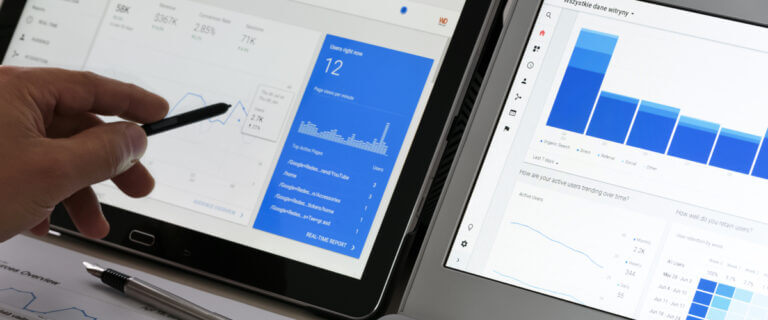If you’ve spent any time in the business world, you’ve probably heard the phrase “data is king.” This phrase has gained widespread usage for a good reason, as data is the foundation of any business’s strategy for maximizing growth in the modern era.
However, knowing how to use the data, or even how to acquire it in general, can be difficult without the prior skillset and knowledge to match. For example, how do you even begin to pull actionable insights from gigantic spreadsheets full of data? Moreover, what kinds of insights can you pull from the data?
In this article, I will dive into the depths of business data, explaining what it is, why it’s important for today’s businesses, and how you can use it to maximize your business’s growth. Let’s get into it.
What is business data?
Although I can immediately jump into defining business data, I think that providing an explanation of what I mean by data in the first place would be useful for understanding the central elements of business data.
According to the Oxford Dictionary, data refers to “facts and statistics collected together for reference or analysis.” Within the definition, you can see that data is meant to be compiled together to be analyzed. This is the key to business data.
Now, with that out of the way, it should be pretty easy to guess what business data is. Business data refers to any piece of information related to the general operations and running of a business. This can take a variety of different forms, whether it be through customer data, internal marketing data, or even the data of your employees.
Within each of these subsets of data, you can have a variety of different forms for the data itself. It can be statistics related to your business’s efficiency, the sales amount for a given product, or the amount of time taken for a single project to be completed by a team. Ultimately, every piece of data can eventually be compiled together (with purpose and reason) and then analyzed to obtain useful information from the data. However, how do you do this?
How do you obtain actionable insights from data?
The process of obtaining actionable insights from data is the job of a data analyst. Their day-to-day typically involves choosing data elements from large databases to analyze, making visualizations with the data in search of patterns, and, when one is found, presenting their findings in an understandable format for a viewer (typically someone with the power to make business decisions) to easily see the significance of the pattern. This task, known as data visualization, is just as important as the analysis itself.
However, you don’t have to be a data analyst to create data visualizations and begin training your pattern-seeking brain. There are numerous different tools out there that not only make this process easy but are also incredibly simple to learn as well. Here is a list of some of the most common tools people utilize for data analysis and visualization today.
- Microsoft Excel
- Python
- Microsoft Power BI
- Tableau
- R and R Studio
- Apache Spark
So, to obtain actionable insights from data, the best course of action would be to learn how to navigate one of these many different data analysis platforms and begin to toy around with databases yourself. There are numerous public databases available online that can allow you to test the waters by creating rudimentary visualizations and seeing what kinds of patterns you can extrapolate from the data. That being said, it may be easier to have someone else analyze for you because, although these tools are easy to pick up, it’s hard to make the time to learn entirely new software on a whim.


Why is business data so important?
Data is an incredibly important tool for any business, simply because it is so versatile. The insights you can draw from data, especially across the many different types of data you can accumulate as a business, are impossible to ignore. For instance, grocery stores can use data they gain from loyalty programs. By attaching a person’s name to their buying habits, they can use algorithms to generate product recommendations and coupons that will encourage them to keep coming back and spending more money.
This, of course, is only one application of business data analysis. In this case, it was used to help maximize and increase profits. However, there are many other ways business data can be used to help grow your business. Here are a few more of them.
Make data-driven decisions with strategic planning
Data can be used to help you make better business decisions in terms of how you plan to expand your business. Here’s an example of how this would work in action.
Imagine that your business wants to expand its marketing endeavors beyond its comfort zone. Let’s say that you have been dabbling across multiple different digital marketing channels, like PPC, SEO with content marketing, and social media. With data, you can keep track of how much money you have put into each one of these channels and determine which of them has had the highest ROI (return on investment). Through this analysis, you can then determine which channel you would like to put more investment into to maximize your business growth.
In addition, you can also use data to increase your customer’s satisfaction. For instance, you can implement split A/B testing throughout email marketing campaigns to see what implementation of elements will spur a more positive customer response.
Implement performance analysis to increase profitability
Data can also be used for performance analysis. I would even argue that business data is the most important tool to push your business toward greater success. Here’s an example of how this could work.
If your business needs any kind of restructuring, whether it be expansion or consolidation, data is the tool you need to figure out where your business should focus its efforts. Perhaps, after checking in on your business’s performance data, your marketing returns year over year has been dwindling. Then, after checking in on your marketing team, you see their strategies haven’t changed in years. Through data, you can then make changes to your marketing team as needed. This principle applies to the entire business as a whole, as by tracking performance with data year over year, you can find, compile, and then analyze trends in the data that will elucidate actionable insights that can take your business to the next level.
As mentioned above, data can also show you where you should focus your efforts as a business, whether that be putting more money into a profitable department or reallocating funds to new areas that show promise.
Types of business data
Business data is a very broad term, to put it lightly. After all, there are so many things that go into running a business that one piece of data is never guaranteed to be even remotely related to another. As such, it’s helpful to put different types of business data into different categories. Here are some of the different types of business data you may come across if you’re looking to perform business data analysis.
Consumer data (demographics, behavior profiles, etc)
The data associated with your customers is referred to as consumer data. This data entails many different qualities associated with your customers. Whether that be the demographic information, their behavioral and buying profiles, or more, this kind of data is integral to building buyer profiles and personas. These personas then allow you to focus further on a specific type of customer that you’d like to attract.
For example, if you’re running a hair salon, you could gather data about what kinds of people come into your salon. Let’s say that your consumer data reveals that the number one demographic of people coming into your salon are younger women in the high school to college range. You can then optimize your advertisements to appeal to that demographic, further capitalizing on and building a niche for your market.
Inventory + supply chain data
Inventory and supply chain data refer to any data related to inventory management and where and how your products move along the supply chain (surprising, I know). This kind of data is incredibly important, especially to any business that sells a physical product. Ensuring you have the right amount of inventory to match demand while also not overproducing is a difficult balance to strike, but data can easily assist you with this endeavor.
Imagine that you’re a clothing manufacturer, and the holiday season is rapidly approaching. You know that you’re going to need more inventory to match the characteristic increased demand of the season, but you aren’t sure of exactly how much that will be. With inventory and supply chain data, you can easily forecast how much inventory you will need during the season based on the previous year’s performance.
Financial data
Financial data can be anything from your business expenses to a breakdown of salaries to year-by-year profits. Essentially, anything that deals with finances can be thrown into the lump of financial data. This data type is incredibly important, as analyzing your financial data is essentially the first step towards profitability when you’re beginning and as you continue to utilize data analytics in your business practices.
It is easy to think of numerous different examples that can exemplify the importance of financial data, but let’s say your business has been investing a ton of money back into a new, experimental project in AI. With financial data, you can see how this project could potentially be serving as a money drain with diminishing returns, or you could realize that despite the fact it’s chewing up your finances, its growth trajectory makes it worth continuing to put time and money into.
Product data
Although this may seem similar to inventory + supply chain data, product data is entirely different. Product data refers to information related to the design, production, distribution, and continued maintenance of a given product. This product doesn’t necessarily have to even be physical, as the way that users interact with software (if you’re a SAAS company) is equally as important to streamline and improve the customer experience.
Imagine that you’re a business selling social media scheduling software, and you’ve noticed a substantial decrease in user base as users are rapidly flocking away from your platform. Through product data analytics, you can pinpoint where the reason behind your dwindling user base lies with the help of customer exit surveys. Then, you could act to fix it and try to market to pull in your previous customers and new ones based on those changes. Maybe your customer’s social media posts kept failing because of a bug you missed in a recent software update, for instance.
Marketing data
Marketing data is not only incredibly important but also our expertise here at Connective. This refers to data related to your marketing efforts, such as the number of clicks you got from an advertisement, the view and bounce rate of your landing pages from a PPC advertisement, and more. Here’s an example from my own experience at Connective.
Content marketing is an integral component of SEO, but for people who don’t necessarily understand the digital marketing landscape, it is hard to conceptualize the importance of consistently pushing out new, high-quality content. However, with data, it’s possible to see this effectiveness with the help of a simple data visualization. A client, after utilizing content marketing, saw a noticeable but steady increase in leads and organic traffic over the course of a year after they began working with us. After presenting these findings and returns, it was easy for them to decide to push further in this marketing channel. Suffice it to say, it has paid off for them in dividends.
Employee data
Last but certainly not least, we have employee data. This refers to the data associated with your employees, including but not limited to their demographics, engagement, time spent on specific tasks, and most importantly, their performance. Through analyzing employee data, it becomes significantly easier to see where you have hidden stars and where you may need some performance improvements.
For instance, if you just lost a manager for a key team, finding a replacement for them may be difficult, especially if you aren’t interested in hiring someone new. However, if you already have or create a spreadsheet detailing your employee’s performance and engagement with the company, finding someone in-house to promote to a new position would be significantly easier.
Challenges of handling business data
As is the case when handling a large database, there are many challenges involved. After all, when you’re utilizing data that is associated with every single facet of your business, you must not only be careful but also be purposeful in the ways that you use it. Here are a few of the most relevant challenges.


Data security
The number one challenge and risk associated with business data is the security of said data. How many times have you heard of a data leak causing panic for people all across the globe? Some of the most relevant and high-scale data breaches are password breaches, wherein millions of users will have their data irreversibly spread all across the web, necessitating a sudden change in their own personal security practices.
How do you navigate this challenge, then? There are two primary ways to help circumvent this, the first being to implement data protection strategies. Some of the most common methods include the following:
- Robust employee education: ensuring that your employees aren’t susceptible to phishing scams ensures that data will not be accidentally leaked from the inside.
- Endpoint security: implementing security measures on each of your endpoints (devices that receive that data) helps further secure the data from potential malware and ransomware problems.
- Data masking and scrambling: implementing methods of encrypting and obfuscating the contents of your data ensures that even if it is intercepted, a bad actor could do nothing with it without knowing how to decrypt it.
- Hyperconvergent infrastructure: this refers to IT frameworks that combine the processes of computing, storage, and networking all in one system. In turn, this reduces the complexity of the operations and increases their scalability. This provides cloud capabilities for your data.
There are certainly other ways to ensure data security and integrity, but these are a few of the important ones to note.
Data integration from various sources
Data integration is an essential part of collecting data but is also multi-faceted and complicated. Specifically, data integration refers to how one collects and synthesizes data from various sources into one coherent view. By performing data integration, one can make the process of viewing and analyzing the data significantly easier, as data integration allows you to access it all from one place. Of course, the challenge comes in putting the data integration process into action.
The details of how to perform data integration depend highly on the types of data that you’re trying to integrate. However, these steps are common throughout any process you decide to implement.
- Define your objectives and requirements: before beginning the process of data integration, be sure you thoroughly understand exactly what you need and are looking for with your data.
- Select your data integration approach: you can approach data integration in a variety of different ways, including but not limited to batch processing (ETL), real-time integration, data virtualization, or a combination of these methods.
- Extract and transform the data: from your sources, begin extracting the data, and then put in the necessary effort to transform the data into your desired format.
- QA and continued maintenance: ideally, your data integration process doesn’t end after one run-through of the pipeline. When done correctly, your data integration process should be scalable and repeatable, allowing you to have a consistent source and method to access your business data and analyze it.
There is certainly more to the process than just these few steps, but this should be a good introduction to the process to help you understand it. I recommend you look further into this process if you’re interested, as it is highly useful to anyone looking to draw further insights from their business data.
Business data examples
Although I have already explored a few hypothetical examples previously in the article, here are a few more to illustrate the importance of business data.
Example 1
The Care Connection is a new business startup focused on making finding a babysitter on the dime easier. However, recently they have seen their business start to slow down; their numbers are dwindling and profits are at an all-time low. Although they initially put more effort into recruiting better babysitters, that was not actually what was causing the decrease in profits. They eventually decided to look into their customer data to see what the issue was, and they found a surprising sight.
By analyzing customer feedback surveys and the demographics of their customers, they realized that their current marketing strategy wasn’t appealing to the right audience; the primary demographic that was utilizing their services wasn’t parents looking for a break for date nights, but rather busy, middle-aged businessmen/women who consistently had to leave home for dinner events. After seeing the data tell a different story than what they expected, they drastically changed their marketing strategy and rhetoric to match their new target demographic, and business started booming all over again.
Example 2
Aura Advocates is an eCommerce business focused on selling products that appeal to people who follow astrology. Their recently redesigned website just launched, and although they were getting more visitors to their site, they weren’t getting an increase in sales as they expected. Confused about the reasoning behind this, they checked their website’s interaction data and found the culprit; although their store page looked aesthetically pleasing, the process of actually navigating from product to product was long-winded and tedious. After some testing, they realized that the average customer would only look at two products before being turned off by the UI and leaving the site. Thanks to the data analysis, Aura Advocates spent some time researching how to best design their store UI to encourage continued browsing, and after another redesign specifically on that page, they were able to truly capitalize on the increase in visitors.
The role of a data analyst in business data
Even if you have all of your data in one place after performing data integration, actually being able to pull actionable insights from the data isn’t an easy task. It takes a skilled and trained eye to do it, and that’s exactly why data analysts have become one of the most in-demand occupations today. With a thorough understanding of statistical methods and data navigation, a data analyst can identify trends, patterns, and correlations within the dataset to extrapolate valuable insights into business performance, customer behavior, and market trends.
On top of simply identifying trends, data analysts also play a valuable role in any business they are a part of by being the go-to person whenever it comes to developing new business strategies. After all, a business data analyst cannot only be well-versed in the technical side of things, but they should also be knowledgeable about the best practices for a business. Overall, a skilled data analyst is vital to analyzing complex business data. Work with someone who has a background in data analysis before you begin trying to analyze the data yourself.
Conclusion
And there it is; an overview of business data and how it is important to any business today. As with everything, there is certainly more to business data than just what I was able to cover in this article, but this should equip you with the knowledge necessary to begin further exploration on your own if you are interested. Regardless of what you choose to do now, I truly appreciate the fact that you read this article to the bottom.
From me to you, I wish you luck in utilizing data to grow your business! Thank you for reading!
Q + A
What role does data analytics play in improving customer experience?
Data analytics plays an integral role in enhancing the customer experience by providing a means to thoroughly analyze customer interactions, preferences, and feedback. By leveraging insights obtained through data analytics, businesses can create personalized offerings, optimize customer touchpoints, and proactively address customer needs and concerns.
How can businesses ensure the quality and accuracy of their data?
Ensuring high standards of data quality requires the implementation of robust data governance practices, conducting regular data audits, and employing data validation processes. Some of the most important steps to guaranteeing accuracy include validating and cleansing data at the source and utilizing data quality tools like OpenRefine and IBM InfoSphere.
How does business data play into the business decision-making processes?
Business data and its analysis serve as the foundation for informed decision-making by providing insights into market trends, customer behavior, and your business’s overall organizational performance. In utilizing business data, the decisions that a business makes will not be based on educated guesses but on facts and trends extrapolated from the data.
How can businesses use predictive analytics to gain a competitive advantage?
By leveraging historical data and statistical knowledge, predictive analytics can forecast future trends and outcomes before they arise. This then gives businesses a competitive edge as they can act upon market changes by optimizing pricing strategies and identifying future risks before their competitors can even move a muscle.












